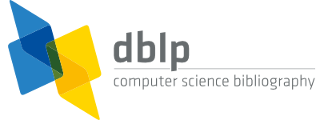


default search action
inroads (ACM SIGCSE Bulletin), Volume 18
Volume 18, Number 1, February 1986
- Joyce Currie Little, Lillian N. Cassel:

Proceedings of the 17th SIGCSE Technical Symposium on Computer Science Education, SIGCSE 1986, Cincinnati, Ohio, USA, February 6-7, 1986. ACM 1986, ISBN 978-0-89791-178-8 [contents]
Volume 18, Number 2, June 1986
- Linda Rising:

Conversions on the net: the professionalism issue. 2-9 - Barbara Doyle:

Should a computer literacy class be the first required course for data processing majors. 10-12 - Andrew P. Bernat:

An interactive interpreter/graphic-simulator for IBM S/370 architecture assembly language. 13-16 - Doris C. Appleby:

And still more on retraining mathematics faculty to teach undergraduate computer science. 17-18 - Brian Lees:

Teaching microcomputer concepts through modelling. 19-24 - Gus W. Baird:

My freshmen learn recursion. 25-28 - William G. Frederick, Maynard J. Mansfield:

An instructional environment for programming using the Vax 11 with a three-colorprojector. 29-30 - Rosemary Schmalz:

Subprograms in the first programming course: an early but non-trivial introduction. 31-32 - Ellen Cunningham:

Fewer control structures considered helpful. 33-34 - Elaine R. Milito, Marsha L. Traub:

Compiler construction: a course outline and project description. 35-37 - Derek Peacock, Paul Manning, Martin P. Lee

 :
:
New microcomputer graphics routines designed for undergraduate teaching. 38-47 - William Myers:

Second language courses are different beasts. 48-50 - Raymond O. Folse:

Pre-college computer use: U.S. versus Japan. 51-52 - Paul W. Oman:

Software engineering practicums: a case study of a senior capstone sequence. 53-57 - Richard J. Reid:

Interactive digital simulation. 58-62 - Neelima Shirkhande, L. P. S. Singh:

The war of languages. 63 - Betty Salzberg:

Third normal form made easy. 64-74 - Gary M. Abshire:

The skills needed to teach computer-science courses HHHHHHHHHHHH. 75-81 - William J. Taffe:

Teaching computer science through writing. 82-83
Volume 18, Number 3
- Orrin E. Taulbee:

Annual U.S. summaries of PH.D. production and employment in computer science. 2-8 - Jerome L. Lewis:

A computational solution to the snowplow problem. 9-12 - Robert J. McGlinn:

Sharing printers in a PC lab. 13-16 - M. C. Lee:

A course in programming languages for computer science majors. 17-18 - Keith Harrow, Yedidyah Langsam, David E. Goldberg:

Teching PL/I using a microcomputer. 19-25 - Lyndell M. Kerley:

Teaching concepts of data structures via the fast Fourier transform. 26-30 - Frank G. Pagan:

On the feasibility of teaching Backus-type functional programming (FP) as a first language. 31-35 - Peter Ramberg:

A new look at an old problem: Keys to success for computer science students. 36-39 - Joan M. Cherry:

Introduction to computer use: A course non-computer science majors at a large. 40-43 - Emery Gathers:

Screening freshmen computer science majors. 44-48 - E. H. Dooijes:

An introductory course in interactive computer graphics. 49-52 - Michael J. Bozonie:

A framework for understanding the computer applications system development process. 53-57 - Yuksel Uckan:

Teaching COBOL in computer information systems programs: Problems, a proposal and an experiment. 58-64
Volume 18, Number 4, December 1986
- Behrooz Parhami:

A geometric view of mutual exclusion and deadlock in computer system. 2-5 - Arthur Gittleman:

Abstraction & modual decomposition - an example. 6-10 - Colleen Deegan, John Atkins, Mike Henry:

OMEGA: A database management system for academic use. 11-14 - G. Michael Schneider:

A proposed redesign of the introductory service course in computer science. 15-21 - Melvin W. Simms:

A career component to the computer science curriculum cooperative education. 22-27 - Dale Shaffer:

The use of Logo in an introductory computer science course. 28-31 - John A. Lehman, Justus D. Naumann:

A language independent course in program design and programming for MIS students. 32-37 - M. O. Adigum:

Software engineering in commercial programming courses. 38-40 - Mark Temte:

An Ada course for upper-level undergraduates. 41-45 - Norman C. Lyster:

The use of the music operating system to supplement the teaching of cobol. 46-49 - Michael K. Mahoney:

Hardware independent programming for a computer graphics course. 50-53 - Nicholas Ourusoff:

The computational view of nature: A liberal arts course in computer science. 54-56 - David V. Moffat:

Teaching a modern data structures course. 57-64 - James Gips:

A robotics course using hero I robots. 65-68 - Anita Zoe Leibowitz:

Exercises for introducing software engineering concepts in a data stuctures course. 69-71 - Cloyd L. Ezell:

A transformation-access model for program visualization action-on-data displays. 72-79 - Larry S. Corman:

Cognitive style, personality type, and learning ability as factors in predicting the success of the beginning programming student. 80-89 - Gordon L. Bailes, Jerry Sayer:

Dealing with independent studies courses - an effective methodology. 90-95

manage site settings
To protect your privacy, all features that rely on external API calls from your browser are turned off by default. You need to opt-in for them to become active. All settings here will be stored as cookies with your web browser. For more information see our F.A.Q.


 Google
Google Google Scholar
Google Scholar Semantic Scholar
Semantic Scholar Internet Archive Scholar
Internet Archive Scholar CiteSeerX
CiteSeerX ORCID
ORCID














